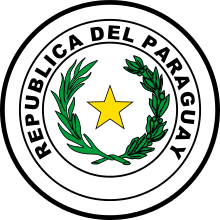Paraguayan constitutional referendum, 1940
 |
| This article is part of a series on the politics and government of Paraguay |
|
Executive |
|
Legislature |
|
A constitutional referendum was held in Paraguay on 4 August 1940.[1] It was the country's first referendum (and until 2011 its only one) and saw voters approve the new constitution.[1]
Background
In 1939 President José Félix Estigarribia responded to a political stalemate by dissolving Congress and declared himself absolute dictator. To dramatize his government's desire for change, he scrapped the existing constitution and produced a new one. The new constitution reflected Estigarribia's desire for stability and power and provided for an extremely powerful state and executive. The President would be elected in direct elections for a term of five years, with re-election permitted for one additional term. They would also be able to intervene in the economy, control the press, suppress private groups, suspend individual liberties, and take exceptional actions for the good of the state. The Senate was abolished and the Chamber of Representatives limited in power. A new advisory Council of State was created, modeled on the experience of corporatist Italy and Portugal, to represent group interests including business, farmers, bankers, the military, and the Roman Catholic Church. The military was responsible for safeguarding the Constitution.[2]
Results
| Choice | Votes | % |
|---|---|---|
| For | 92.4 | |
| Against | 7.6 | |
| Invalid/blank votes | – | |
| Total | 100 | |
| Registered voters/turnout | 80 | |
| Source: Direct Democracy | ||
References
- 1 2 Nohlen, D (2005) Elections in the Americas: A data handbook, Volume II, p428 ISBN 978-0-19-928358-3
- ↑ Thomas C. Bruneau. "Constitutional Development". Paraguay: A country study (Dannin M. Hanratty and Sandra W. Meditz, eds.). Library of Congress Federal Research Division (December 1988).
 This article incorporates text from this source, which is in the public domain.
This article incorporates text from this source, which is in the public domain.